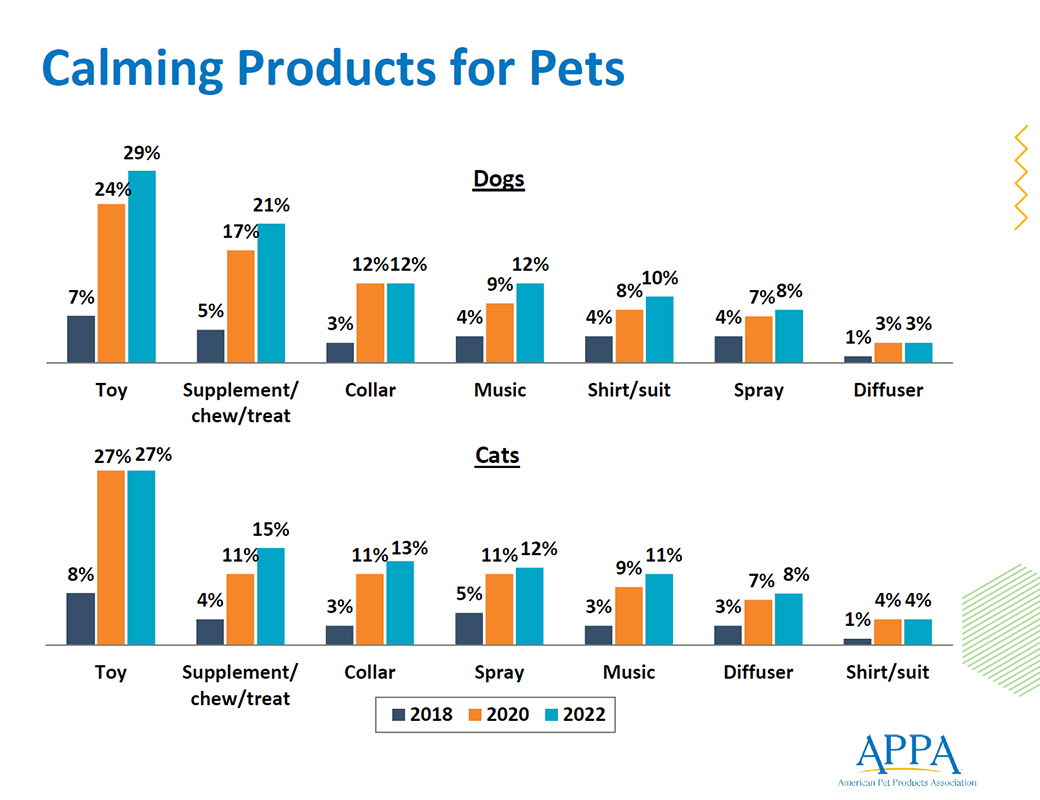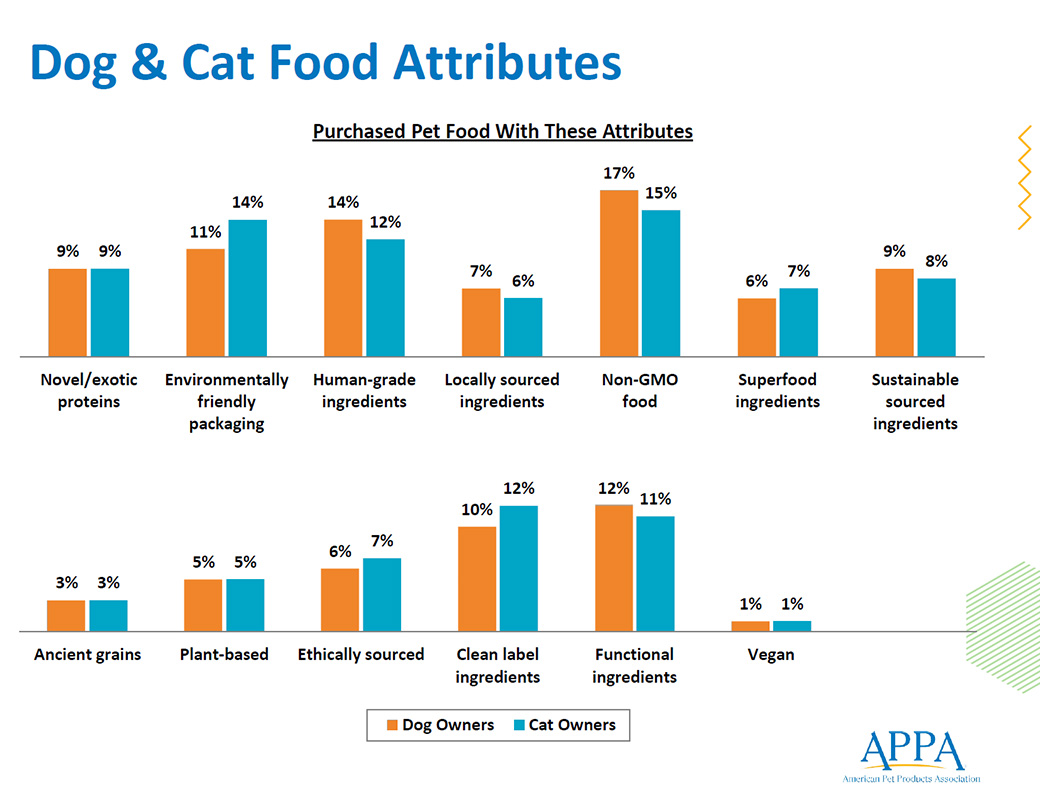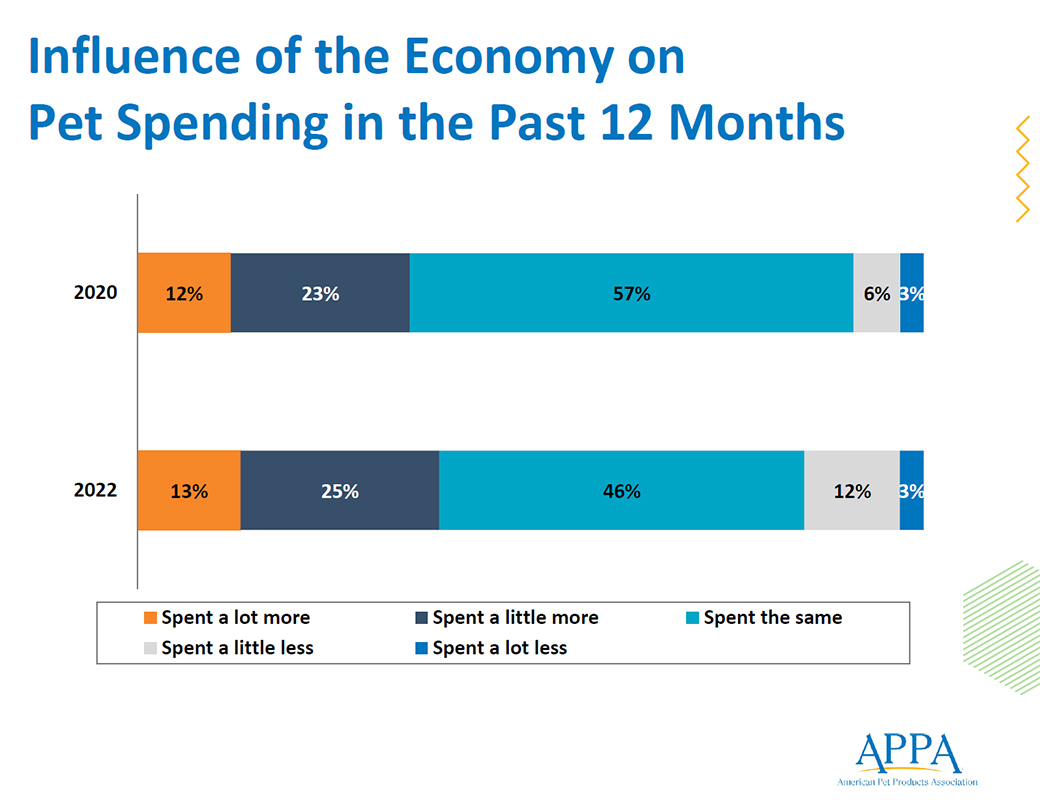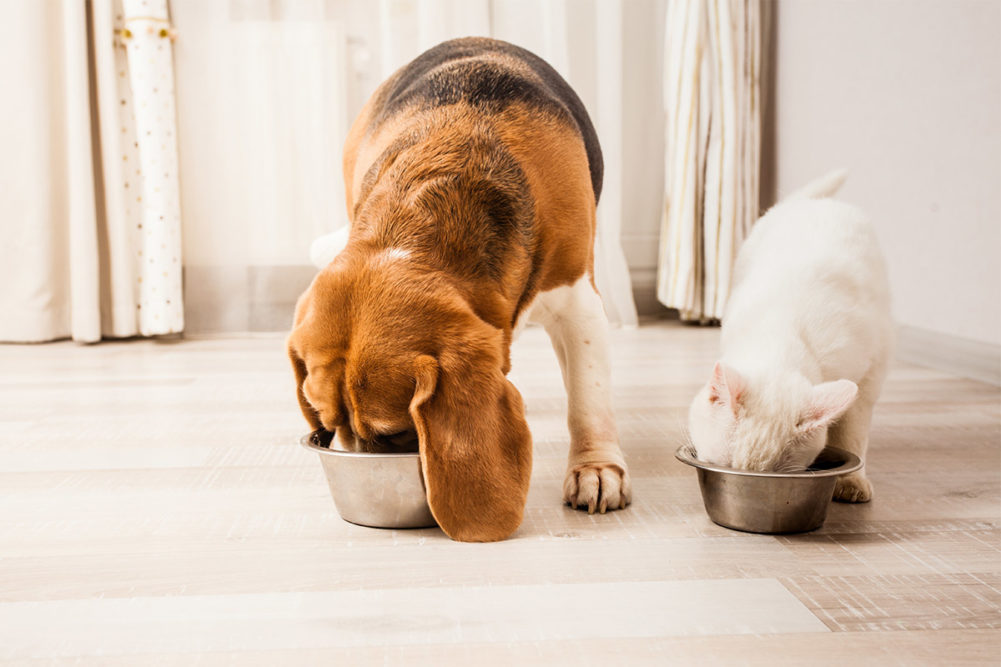Read more from APPA’s Global Pet Expo 2023 presentation in our other article, “Younger generations now make up half of all US pet-owning households."
ORLANDO, FLA. — Despite inflationary pressures, pet owners are willing to spend more for certain product attributes, according to the American Pet Products Association’s (APPA) 2023-2024 National Pet Owners Survey. These attributes include products made in the United States (60% of pet owners), brand name products (55%), ethically sourced pet products (52%), eco-friendly products (49%) and BPA-free products (49%).
Julie Springer, market research analyst at APPA, shared top-level findings from the report, including key product attributes for dog and cat owners, at Global Pet Expo 2023, held March 22 to 24 in Orlando.
Function forward
Vitamin and supplement use among dog and cat owners is on the rise, with 48% of dog owners administering these products to their pets in 2022 — up from 34% in 2018 — and 32% of cat owners giving their feline companions these types of products in 2022 — up from 20% in 2018.
Along this vein, calming products for dogs and cats are increasing in popularity. Calming toys were the most popular in 2022, with 29% of dog owners and 27% of cat owners using them, but calming supplements, chews and treats were the second-most popular among 21% of dog owners and 15% of cat owners, compared to just 5% and 4%, respectively, in 2018.
 Source: American Pet Products Association
Source: American Pet Products Association
Dog and cat owners are also increasingly purchasing pet treats containing CBD. According to APPA, 26% of dog owners purchased CBD treats in 2022, compared to 24% in 2020. This product category is the most popular among both dog and cat owners.
APPA also asked pet owners why they purchase CBD products for their pets, and found that 25% of dog owners bought them to address anxiety or stress in 2022 (up from 19% in 2020), 15% for arthritis or joint pain (up from 14% in 2020), and 14% for pain (up from 13% in 2020). Among cat owners, 23% purchased CBD products for anxiety or stress in 2022 (up from 18% in 2020), 16% for pain (up from 13% in 2020), and 14% for arthritis or joint pain (up from 12% in 2020). Cat owners are also seeking CBD products to address loss of appetite or digestive issues, with 11% citing these reasons for CBD cat product purchases in 2022, up from 8% in 2020.
Sought-after attributes
The survey showed roughly 9% of dogs and 15% of cats are considered overweight by their owners, while 9% of dogs and 12% of cats are on a special diet. However, 29% of cat owners reported feeding basic or generic cat food most often, followed by 27% of owners who most often feed their felines premium diets. Among dog owners, 34% typically feed premium dog food, while 18% most often feed basic or generic diets.
Pet owners continue to purchase natural, grain-free, organic, limited-ingredient and meal mixer products. According to APPA, 20% of dog owners and 19% of cat owners purchase natural pet food; 14% of dog and cat owners purchase grain-free diets; 11% of dog and cat owners purchase organic pet food; 8% of dog owners and 9% of cat owners purchase limited-ingredient diets; and 10% of dog owners and 12% of cat owners purchase meal mixers.
Other pet food attributes making their way into pet owners’ shopping carts include non-GMO (17% of dog owners and 15% of cat owners), environmentally friendly packaging (11% of dog owners and 14% of cat owners), human-grade ingredients (14% of dog owners and 12% of cat owners), clean label ingredients (10% of dog owners and 12% of cat owners), and functional ingredients (12% of dog owners and 11% of cat owners).
 Source: American Pet Products Association
Source: American Pet Products Association
Novel proteins — referring to non-traditional options like venison, rabbit, wild boar, alligator and others — are becoming more popular among pet parents as well. According to APPA, 9% of both dog and cat owners are purchasing novel protein diets, with 56% of dog owners and 41% of cat owners buying food containing venison protein. Additionally, 30% of dog owners and 43% of cat owners are purchasing pet food with rabbit protein, while 28% of dog owners and 21% of cat owners are buying food with wild boar protein.
Diets featuring insect protein, quail and pheasant are also being bought by cat owners, with 25% purchasing insect protein diets, 31% purchasing food with quail protein, and 22% purchasing diets with pheasant protein.
Spending habits
According to APPA, 21% of dog owners and 24% of cat owners considered brand names to be “very important” in 2022, up slightly from 20% and 23%, respectively, in 2018. While brand loyalty remains an important factor for these pet owners, economic impacts are straining spending. APPA reported 39% of pet owners spent more on their pets over the last 12 months — namely on food — while 15% spent less. However, most pet owners (46%) spent the same in 2022 as in 2021, but this is down from 57% of pet owners who maintained their pet spending from 2019 to 2020.
 Source: American Pet Products Association
Source: American Pet Products Association
Overall, dog owners spent an average of $354 on pet food in 2022, up from $259 in 2018 and $287 in 2020. Cat owners spent an average of $300 on cat food in 2022, up from $228 in 2018 and $254 in 2020.
When it comes to treating, 94% of dog owners and 91% of cat owners reported purchasing treats for their companions in 2022. Treat purchasing rates are up from 92% and 86%, respectively, in 2018. Spending on treats has also increased from 2018 to 2022, with dog owners spending an average of $102 on treats in 2022, up from $76 in 2018 and $81 in 2020, and cat owners spending an average of $78 on treats in 2022, up from $58 in 2018 and $72 in 2020.
These increased pet nutrition expenditures are likely the combined result of two factors: pet product inflation and the continued proliferation of the pet food and treat market. Rising pet nutrition sales in recent years can be attributed in part to emerging premium formats cropping up in the market.
Read more from APPA’s Global Pet Expo 2023 presentation in our other article, “Younger generations now make up half of all US pet-owning households."
Keep up with the latest pet food trends on our Trends page.




